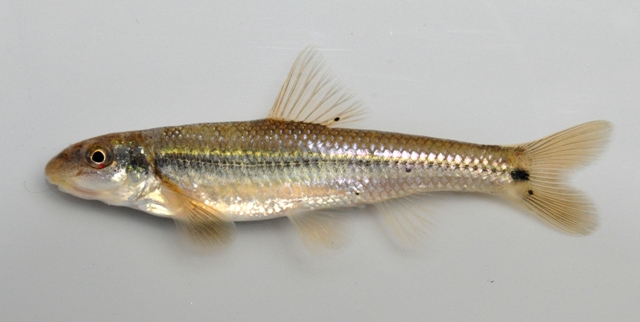Suckermouth Minnow
(Phenacobius mirabilis)

Historically the suckermouth minnow was not found in Ohio. As many forest and prairies were cleared to make way for farmland, which in turn caused streams and rivers to become more turbid, the species expanded eastward. The original range of the suckermouth minnow may not have come east of the Mississippi River.
Description
Suckermouth minnows get their name from a distinctly sub-terminal (ending below tip of snout) mouth. This gives them the appearance of a small sucker. However, all species of suckers have the anal fin positioned closer to the tail and have more than 8 dorsal fin rays. Suckermouth minnows have a narrow dark stripe down the side which ends in a dark spot at the base of the tail. Immediately above this dark line is a narrow gold line. They have a darker gray or brown back and a light cream to white belly. The sides of the body can be silvery or a light brown and there are no spots or other distinct markings on the fins.
Habitat and Habits
Suckermouth minnows are found in medium to large rivers in swift flowing riffles and gravel runs. They are very tolerant of turbid (murky) waters and actually seem to have a preference for murky waters. Only when the swift riffles become covered in silt do they disappear from a given locality. Historically this species was probably not found in Ohio and may only have been found in the plains west of the Mississippi River. As prairies and forests were cleared to make way for farming and streams and rivers became more turbid (murky) the suckermouth minnow expanded its range eastward. The first individuals were found in Illinois and Indiana in 1876. They were then first recorded in Ohio in 1920. Since that time they have spread throughout Ohio and are common in many larger streams and rivers particularly in the western part of the state.
Reproduction and Care of the Young
Suckermouth minnows spawn in gravel riffles in April and May. No parental care is given to the eggs or young.